Submitted:
21 February 2024
Posted:
22 February 2024
You are already at the latest version
Abstract
Keywords:
1. Introduction
- Limitation 1: Grab sampling is usually carried out by staff of the governmental environmental agencies, employed with regular working hours. Thereby, it is rare to have nighttime samples. Especially for parameters that have a diurnal pattern like dissolved oxygen (DO), pH or NO3-N only daytime sampling introduces systematic errors and leads to an over- or underestimation of the true value [16]. For example, Minaudo et al. (2015) [17] showed that the diurnal amplitude for the DO concentration can be of several mg/l during summer, especially for eutrophic rivers. As DO is highest during light periods, those rivers would be categorized better than they are [11].
- Limitation 2: (Heavy) rainfall events cause discharge higher than baseflow, mobilizing particles and particle bound nutrients/pollutants within the catchment or the stream bed. Such events may cause considerable variation in the concentrations of particle-bound compounds. They often account for the majority of the annual load of pollutants in large and also smaller river systems [18,19,20]. Depending on many factors including land use, season, length of the antecedent dry weather period and others, they can reach considerable concentrations and loads in creeks and streams [21,22]. Rabiet et al. 2010 showed that more than 89% of the total load of the herbicide diuron was mobilized during storms in August 2007; Glaser et al. 2020 and Zhou et al. 2022 obtained similar results for the load mobilization of PAHs and pesticides [19,23,24]. Particle mobilizing events occur rarely and with a short duration, which reduces the probability to capture them with a monthly grab sampling regime. Skarbøvik et al. (2012) [25] analyzed the effect of sampling frequency of suspended sediments, on the load calculation and showed that weekly sampling resulted in error rates as high as 70%, monthly sampling could yield errors up to 400%. However, other studies, e.g. by Torres et al. (2022) [26] indicated that even constituents easily transported by water (such as sediments and nutrients) require more than 50 samples/year to provide a small error (< 10%, 95% confidence interval).
2. Materials and Methods
Catchments and monitoring sites
Water quality and discharge data
Modelling of the sampling strategies
Modelling of grab sampling
Modelling of short-term online-monitoring - STOM
Modelling of sampling during events
Uncertainty of sampling strategies
Cost Calculation
- Grab sampling is assumed to be carried out 12 times per year
- 8 € per sample for the analysis of NO3-N and Cl, O2 is measured on site with a hand-held for 642 € per year (4500 € over seven years depreciation period)
- Driving costs of 4.5 € per site and 240 € personnel costs per sampling day (8 hours with an hourly wage of 30€)
- Intervals for STOM are varying on the different application scenarios
- Multi Parameter Probe (15 000 €) with a depreciation period of seven years (2143 €/year). Number of sensors is depending on return intervals and duration of sensor application.
- Driving and personnel costs based on the values of grab sampling but multiplied by two, since the sensor needs to be installed and picked up.
3. Results
Water quality parameters
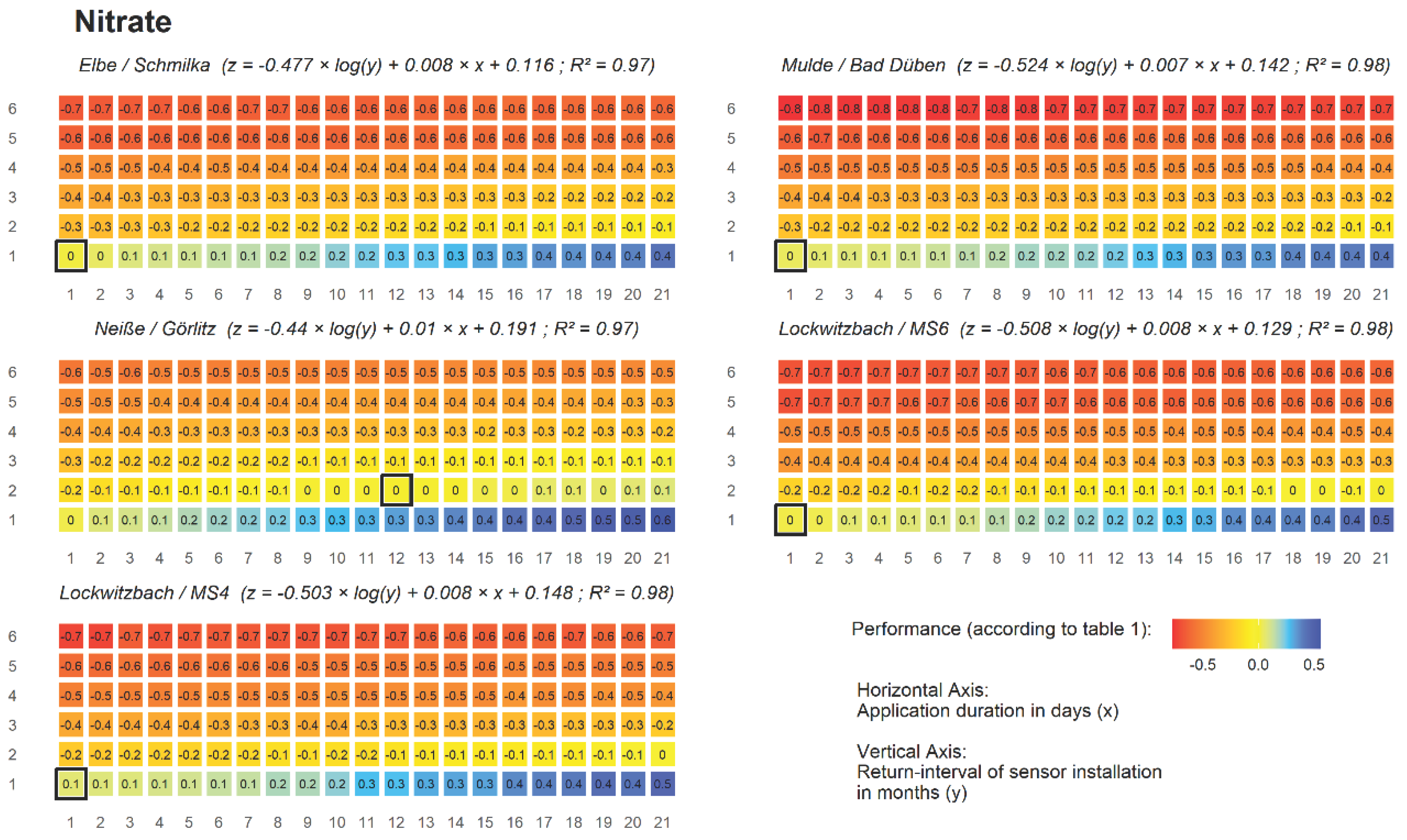
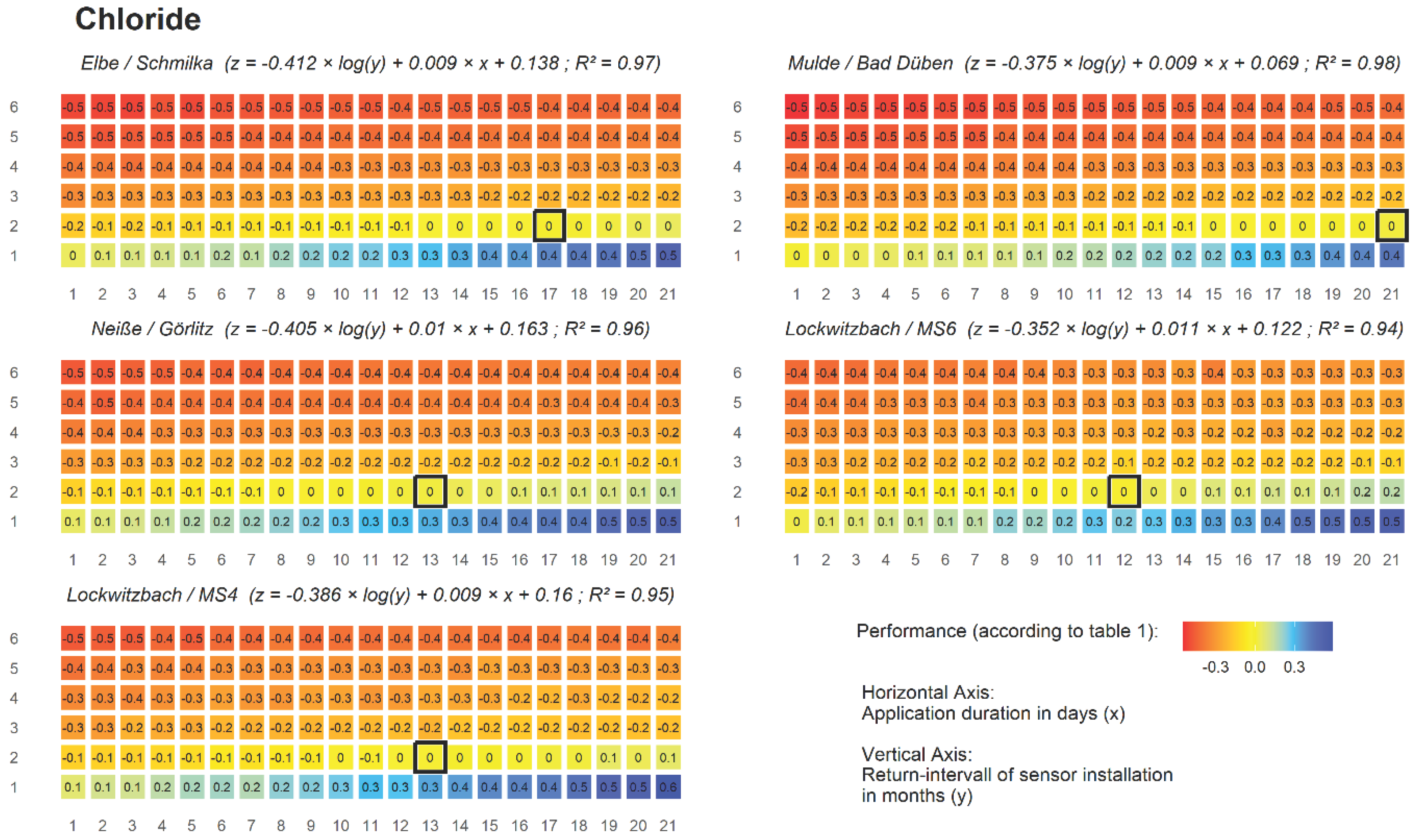
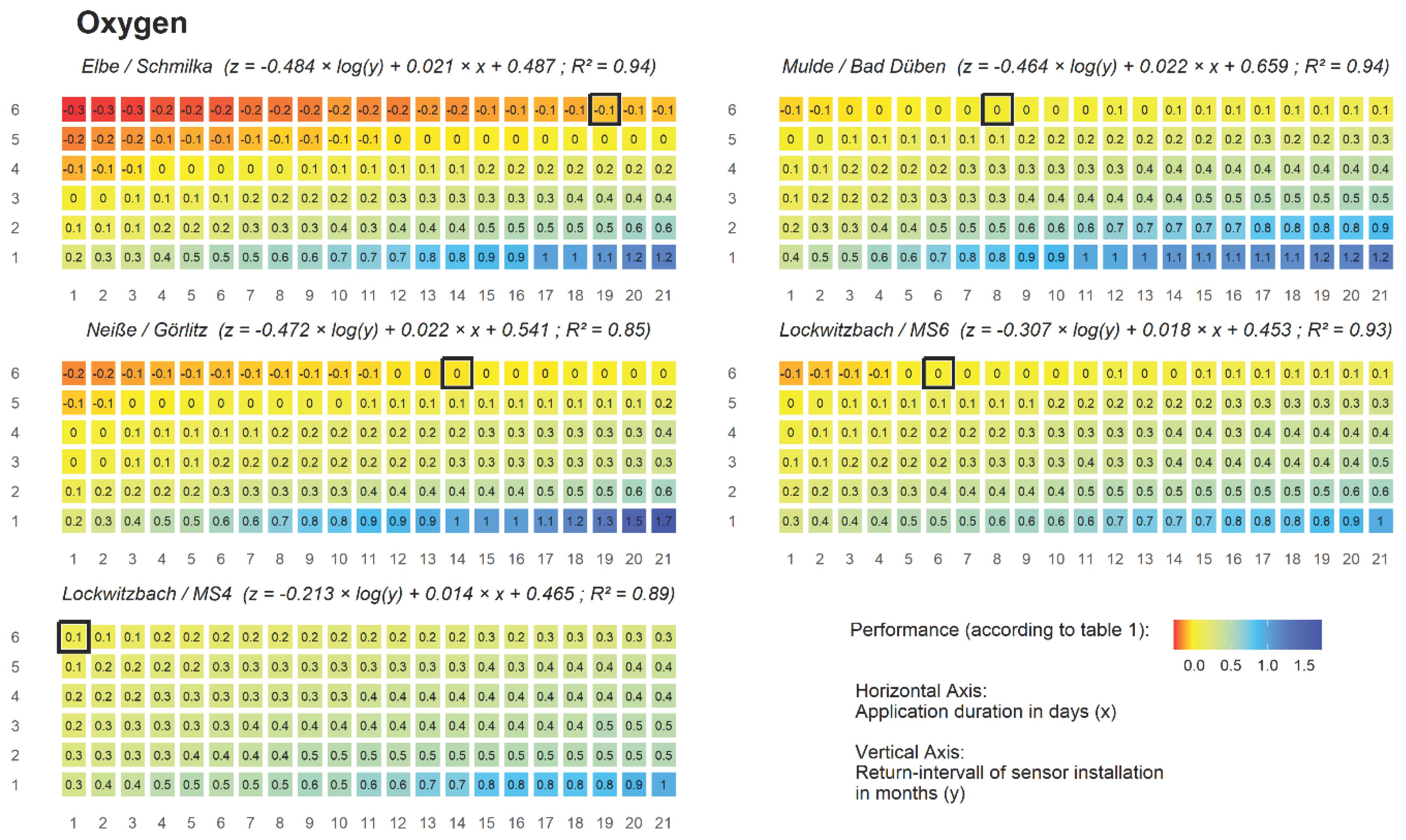
Sampling during events
Uncertainty of the sampling strategies
Cost calculation
4. Discussion
Water Quality Parameters
Estimation of chloride concentration
Performance of STOM in comparison to grab sampling
STOM and event sampling
STOM for modelling
Cost Calculation
5. Conclusions
Supplementary Materials
Author Contributions
Funding
Data Availability Statement
Acknowledgments
Conflicts of Interest
References
- LAWA-Ausschuss „Oberirdische Gewässer und Küstengewässer“ Rahmenkonzeption Zur Aufstellung von Monitoringprogrammen Und Zur Bewertung Des Zustands von Oberflächengewässern: 2021. 2.
- Hanke, G.; Lepom, P.; Quevauviller, P.; Allan, J.; Batty, J.; Bignert, A.; Borga, K.; Boutrup, S.; Brown, B.; Carere, M. Guidance Document No. 19 Guidance on Surface Water Chemical Monitoring under the Water Framework Directive. 2009. [Google Scholar]
- WFD-CIS Guidance Document No. 7. Monitoring under the Water Framework Directive Luxembourg. 2003.
- European Commission; Directorate-General for the Environment Guidance on Surface Water Chemical Monitoring under the Water Framework Directive.; 2009.
- Allan, I.J.; Vrana, B.; Greenwood, R.; Mills, G.A.; Knutsson, J.; Holmberg, A.; Guigues, N.; Fouillac, A.-M.; Laschi, S. Strategic Monitoring for the European Water Framework Directive. TrAC Trends in Analytical Chemistry 2006, 25, 704–715. [Google Scholar] [CrossRef]
- Brack, W.; Dulio, V.; Ågerstrand, M.; Allan, I.; Altenburger, R.; Brinkmann, M.; Bunke, D.; Burgess, R.M.; Cousins, I.; Escher, B.I. Towards the Review of the European Union Water Framework Management of Chemical Contamination in European Surface Water Resources. Science of the total environment 2017, 576, 720–737. [Google Scholar] [CrossRef]
- Carvalho, L.; Mackay, E.B.; Cardoso, A.C.; Baattrup-Pedersen, A.; Birk, S.; Blackstock, K.L.; Borics, G.; Borja, A.; Feld, C.K.; Ferreira, M.T.; et al. Protecting and Restoring Europe’s Waters: An Analysis of the Future Development Needs of the Water Framework Directive. Science of The Total Environment 2019, 658, 1228–1238. [Google Scholar] [CrossRef]
- Hering, D.; Borja, A.; Carstensen, J.; Carvalho, L.; Elliott, M.; Feld, C.K.; Heiskanen, A.-S.; Johnson, R.K.; Moe, J.; Pont, D. The European Water Framework Directive at the Age of 10: A Critical Review of the Achievements with Recommendations for the Future. Science of the total Environment 2010, 408, 4007–4019. [Google Scholar] [CrossRef]
- Carstensen, J. Statistical Principles for Ecological Status Classification of Water Framework Directive Monitoring Data. Marine Pollution Bulletin 2007, 55, 3–15. [Google Scholar] [CrossRef] [PubMed]
- László, B.; Szilágyi, F.; Szilágyi, E.; Heltai, G.; Licskó, I. Implementation of the EU Water Framework Directive in Monitoring of Small Water Bodies in Hungary, I. Establishment of Surveillance Monitoring System for Physical and Chemical Characteristics for Small Mountain Watercourses. Microchemical Journal 2007, 85, 65–71. [Google Scholar] [CrossRef]
- Vilmin, L.; Flipo, N.; Escoffier, N.; Groleau, A. Estimation of the Water Quality of a Large Urbanized River as Defined by the European WFD: What Is the Optimal Sampling Frequency? Environmental Science and Pollution Research 2018, 25, 23485–23501. [Google Scholar] [CrossRef]
- Wang, J.; Bouchez, J.; Dolant, A.; Floury, P.; Stumpf, A.J.; Bauer, E.; Keefer, L.; Gaillardet, J.; Kumar, P.; Druhan, J.L. Sampling Frequency, Load Estimation and the Disproportionate Effect of Storms on Solute Mass Flux in Rivers. Science of The Total Environment 2023, 167379. [Google Scholar] [CrossRef]
- Halliday, S.J.; Skeffington, R.A.; Wade, A.J.; Bowes, M.J.; Gozzard, E.; Newman, J.R.; Loewenthal, M.; Palmer-Felgate, E.J.; Jarvie, H.P. High-frequency Water Quality Monitoring in an Urban Catchment: Hydrochemical Dynamics, Primary Production and Implications for the Water Framework Directive. Hydrological Processes 2015, 29, 3388–3407. [Google Scholar] [CrossRef]
- Naddeo, V.; Scannapieco, D.; Zarra, T.; Belgiorno, V. River Water Quality Assessment: Implementation of Non-Parametric Tests for Sampling Frequency Optimization. Land Use Policy 2013, 30, 197–205. [Google Scholar] [CrossRef]
- Skeffington, R.A.; Halliday, S.J.; Wade, A.J.; Bowes, M.J.; Loewenthal, M. Using High-Frequency Water Quality Data to Assess Sampling Strategies for the EU Water Framework Directive. Hydrology and Earth System Sciences 2015, 19, 2491–2504. [Google Scholar] [CrossRef]
- Halliday, S.J.; Wade, A.J.; Skeffington, R.A.; Neal, C.; Reynolds, B.; Rowland, P.; Neal, M.; Norris, D. An Analysis of Long-Term Trends, Seasonality and Short-Term Dynamics in Water Quality Data from Plynlimon, Wales. Science of the Total Environment 2012, 434, 186–200. [Google Scholar] [CrossRef]
- Minaudo, C.; Meybeck, M.; Moatar, F.; Gassama, N.; Curie, F. Eutrophication Mitigation in Rivers: 30 Years of Trends in Spatial and Seasonal Patterns of Biogeochemistry of the Loire River (1980–2012). Biogeosciences 2015, 12, 2549–2563. [Google Scholar] [CrossRef]
- Owens, P. Conceptual Models and Budgets for Sediment Management at the River Basin Scale (12 Pp). Journal of soils and sediments 2005, 5, 201–212. [Google Scholar] [CrossRef]
- Rabiet, M.; Margoum, C.; Gouy, V.; Carluer, N.; Coquery, M. Assessing Pesticide Concentrations and Fluxes in the Stream of a Small Vineyard Catchment–Effect of Sampling Frequency. Environmental pollution 2010, 158, 737–748. [Google Scholar] [CrossRef]
- Zonta, R.; Collavini, F.; Zaggia, L.; Zuliani, A. The Effect of Floods on the Transport of Suspended Sediments and Contaminants: A Case Study from the Estuary of the Dese River (Venice Lagoon, Italy). Environment international 2005, 31, 948–958. [Google Scholar] [CrossRef] [PubMed]
- Lintern, A.; Webb, J.A.; Ryu, D.; Liu, S.; Bende-Michl, U.; Waters, D.; Leahy, P.; Wilson, P.; Western, A.W. Key Factors Influencing Differences in Stream Water Quality across Space. Wiley Interdisciplinary Reviews: Water 2018, 5, e1260. [Google Scholar] [CrossRef]
- McClain, M.E.; Boyer, E.W.; Dent, C.L.; Gergel, S.E.; Grimm, N.B.; Groffman, P.M.; Hart, S.C.; Harvey, J.W.; Johnston, C.A.; Mayorga, E.; et al. Biogeochemical Hot Spots and Hot Moments at the Interface of Terrestrial and Aquatic Ecosystems. Ecosystems 2003, 6, 301–312. [Google Scholar] [CrossRef]
- Glaser, C.; Zarfl, C.; Rügner, H.; Lewis, A.; Schwientek, M. Analyzing Particle-Associated Pollutant Transport to Identify in-Stream Sediment Processes during a High Flow Event. Water 2020, 12, 1794. [Google Scholar] [CrossRef]
- Zhou, M.; Wu, S.; Zhang, Z.; Aihemaiti, Y.; Yang, L.; Shao, Y.; Chen, Z.; Jiang, Y.; Jin, C.; Zheng, G. Dilution or Enrichment: The Effects of Flood on Pollutants in Urban Rivers. Environmental Sciences Europe 2022, 34, 1–12. [Google Scholar] [CrossRef]
- Skarbøvik, E.; Stålnacke, P.; Bogen, J.; Bønsnes, T.E. Impact of Sampling Frequency on Mean Concentrations and Estimated Loads of Suspended Sediment in a Norwegian River: Implications for Water Management. Science of the Total Environment 2012, 433, 462–471. [Google Scholar] [CrossRef]
- Torres, C.; Gitau, M.W.; Paredes-Cuervo, D.; Engel, B. Evaluation of Sampling Frequency Impact on the Accuracy of Water Quality Status as Determined Considering Different Water Quality Monitoring Objectives. Environmental Monitoring and Assessment 2022, 194, 1–23. [Google Scholar] [CrossRef]
- Bieroza, M.Z.; Heathwaite, A.L.; Mullinger, N.J.; Keenan, P.O. Understanding Nutrient Biogeochemistry in Agricultural Catchments: The Challenge of Appropriate Monitoring Frequencies. Environmental Science: Processes & Impacts 2014, 16, 1676–1691. [Google Scholar]
- Elwan, A.; Singh, R.; Patterson, M.; Roygard, J.; Horne, D.; Clothier, B.; Jones, G. Influence of Sampling Frequency and Load Calculation Methods on Quantification of Annual River Nutrient and Suspended Solids Loads. Environmental monitoring and assessment 2018, 190, 1–18. [Google Scholar] [CrossRef]
- Pace, S.; Hood, J.M.; Raymond, H.; Moneymaker, B.; Lyon, S.W. High-Frequency Monitoring to Estimate Loads and Identify Nutrient Transport Dynamics in the Little Auglaize River, Ohio. Sustainability 2022, 14, 16848. [Google Scholar] [CrossRef]
- Piniewski, M.; Marcinkowski, P.; Koskiaho, J.; Tattari, S. The Effect of Sampling Frequency and Strategy on Water Quality Modelling Driven by High-Frequency Monitoring Data in a Boreal Catchment. Journal of Hydrology 2019, 579, 124186. [Google Scholar] [CrossRef]
- Robertson, D.M.; Roerish, E.D. Influence of Various Water Quality Sampling Strategies on Load Estimates for Small Streams. Water Resources Research 1999, 35, 3747–3759. [Google Scholar] [CrossRef]
- Capodaglio, A.G.; Callegari, A. Online Monitoring Technologies for Drinking Water Systems Security. In Proceedings of the Risk Management of Water Supply and Sanitation Systems; Springer, 2009; pp. 153–179. [Google Scholar]
- Benisch, J.; Wagner, B.; Förster, C.; Helm, B.; Grummt, S.; Krebs, P. Application of a High-Resolution Measurement System with Hydrodynamic Modelling for the Integrated Quantification of Urbanization Effects on a Creek.; Prague, 2017.
- LfULG Sächsische Beiträge Zu Den Bewirtschaftungsplänen 2022-2027; Referat Oberflächenwasser, Wasserrahmenrichtlinie, 2021.
- European Environment Agency; European Environment Agency CORINE Land Cover 2012 (Raster 100 m), Europe, 6-Yearly - Version 2020_20u1, May 2020 2019. 20 May.
- OGewV Oberflächengewässerverordnung; 2016.
- Gustard, A.; Bullock, A.; Dixon, J.M. Low Flow Estimation in the United Kingdom; Institute of Hydrology, 1992; ISBN 0-948540-45-1. [Google Scholar]
- Kissel, M.; Schmalz, B. Comparison of Baseflow Separation Methods in the German Low Mountain Range. Water 2020, 12, 1740. [Google Scholar] [CrossRef]
- R Core Team R: A Language and Environment for Statistical Computing. 2023.
- Trowbridge, P.R.; Kahl, J.S.; Sassan, D.A.; Heath, D.L.; Walsh, E.M. Relating Road Salt to Exceedances of the Water Quality Standard for Chloride in New Hampshire Streams. Environmental science & technology 2010, 44, 4903–4909. [Google Scholar]
- Zuidema, S.; Wollheim, W.M.; Mineau, M.M.; Green, M.B.; Stewart, R.J. Controls of Chloride Loading and Impairment at the River Network Scale in New England. Journal of environmental quality 2018, 47, 839–847. [Google Scholar] [CrossRef] [PubMed]
- Perera, N.; Gharabaghi, B.; Noehammer, P. Stream Chloride Monitoring Program of City of Toronto: Implications of Road Salt Application. Water Quality Research Journal 2009, 44, 132–140. [Google Scholar] [CrossRef]
- Loewenthal, M. YSI Catchment Monitoring Network Protects Thames River; 2008.
- Winter, C.; Tarasova, L.; Lutz, S.R.; Musolff, A.; Kumar, R.; Fleckenstein, J.H. Explaining the Variability in High-frequency Nitrate Export Patterns Using Long-term Hydrological Event Classification. Water Resources Research 2022, 58, e2021WR030938. [Google Scholar] [CrossRef]
- Rusjan, S.; Mikoš, M. Seasonal Variability of Diurnal In-Stream Nitrate Concentration Oscillations under Hydrologically Stable Conditions. Biogeochemistry 2010, 97, 123–140. [Google Scholar] [CrossRef]
- Scholefield, D.; Le Goff, T.; Braven, J.; Ebdon, L.; Long, T.; Butler, M. Concerted Diurnal Patterns in Riverine Nutrient Concentrations and Physical Conditions. Science of the total environment 2005, 344, 201–210. [Google Scholar] [CrossRef]
- Harmeson, R.H.; Barcelona, M.J. Sampling Frequency for Water Quality Monitoring. ISWS Contract Report CR 279 1981. [Google Scholar]
- Situ, Q.; Akther, M.; He, J. Seasonal and Temporal Variations of Chloride Level in Riverine Environment 2018.
- Corsi, S.R.; De Cicco, L.A.; Lutz, M.A.; Hirsch, R.M. River Chloride Trends in Snow-Affected Urban Watersheds: Increasing Concentrations Outpace Urban Growth Rate and Are Common among All Seasons. Science of the Total Environment 2015, 508, 488–497. [Google Scholar] [CrossRef]
- Dugan, H.A.; Rock, L.A.; Kendall, A.D.; Mooney, R.J. Tributary Chloride Loading into Lake Michigan. Limnology and Oceanography Letters 2023, 8, 83–92. [Google Scholar] [CrossRef]
- Cañedo-Argüelles, M.; Kefford, B.J.; Piscart, C.; Prat, N.; Schäfer, R.B.; Schulz, C.-J. Salinisation of Rivers: An Urgent Ecological Issue. Environmental pollution 2013, 173, 157–167. [Google Scholar] [CrossRef]
- Ramakrishna, D.M.; Viraraghavan, T. Environmental Impact of Chemical Deicers–a Review. Water, Air, and Soil Pollution 2005, 166, 49–63. [Google Scholar] [CrossRef]
- Szklarek, S.; Górecka, A.; Wojtal-Frankiewicz, A. The Effects of Road Salt on Freshwater Ecosystems and Solutions for Mitigating Chloride Pollution-A Review. Science of The Total Environment 2022, 805, 150289. [Google Scholar] [CrossRef]
- CEQG Canadian Water Quality Guidelines for the Protection of Aquatic; Life Qual. Guidel. 1-9; 2011.
- US EPA Ambient Aquatic Life Water Quality Criteria for Chloride. PB88-175 1988, 47.
- Lawler, D.M.; Foster, I.D.; Petts, G.E.; Harper, S. Suspended Sediment Dynamics for June Storm Events in the Urbanized River Tame, UK. In; IAHS Press, 2006. ISBN 1-901502-68-6.
- Doucette, W.J. Quantitative Structure-activity Relationships for Predicting Soil-sediment Sorption Coefficients for Organic Chemicals. Environmental Toxicology and Chemistry: An International Journal 2003, 22, 1771–1788. [Google Scholar] [CrossRef]
- Bende-Michl, U.; Hairsine, P.B. A Systematic Approach to Choosing an Automated Nutrient Analyser for River Monitoring. Journal of Environmental Monitoring 2010, 12, 127–134. [Google Scholar] [CrossRef]
- Babitsch, D.; Berger, E.; Sundermann, A. Linking Environmental with Biological Data: Low Sampling Frequencies of Chemical Pollutants and Nutrients in Rivers Reduce the Reliability of Model Results. Science of the Total Environment 2021, 772, 145498. [Google Scholar] [CrossRef]
- Jiang, S.Y.; Zhang, Q.; Werner, A.D.; Wellen, C.; Jomaa, S.; Zhu, Q.D.; Büttner, O.; Meon, G.; Rode, M. Effects of Stream Nitrate Data Frequency on Watershed Model Performance and Prediction Uncertainty. Journal of Hydrology 2019, 569, 22–36. [Google Scholar] [CrossRef]
- Tsakiris, G.; Alexakis, D. Water Quality Models: An Overview. European Water 2012, 37, 33–46. [Google Scholar]
- Nafees Ahmad, H.M.; Sinclair, A.; Jamieson, R.; Madani, A.; Hebb, D.; Havard, P.; Yiridoe, E.K. Modeling Sediment and Nitrogen Export from a Rural Watershed in Eastern Canada Using the Soil and Water Assessment Tool. Journal of Environmental Quality 2011, 40, 1182–1194. [Google Scholar] [CrossRef] [PubMed]
- Kirchner, J.W.; Feng, X.; Neal, C.; Robson, A.J. The Fine Structure of Water-quality Dynamics: The (High-frequency) Wave of the Future. Hydrological Processes 2004, 18, 1353–1359. [Google Scholar] [CrossRef]
- Rode, M.; Halbedel née Angelstein, S.; Anis, M.R.; Borchardt, D.; Weitere, M. Continuous In-Stream Assimilatory Nitrate Uptake from High-Frequency Sensor Measurements. Environmental Science & Technology 2016, 50, 5685–5694. [Google Scholar] [CrossRef]
- Meyer, A.M.; Klein, C.; Fünfrocken, E.; Kautenburger, R.; Beck, H.P. Real-Time Monitoring of Water Quality to Identify Pollution Pathways in Small and Middle Scale Rivers. Science of the Total Environment 2019, 651, 2323–2333. [Google Scholar] [CrossRef] [PubMed]
- Meyer, A.M.; Fuenfrocken, E.; Kautenburger, R.; Cairault, A.; Beck, H.P. Detecting Pollutant Sources and Pathways: High-Frequency Automated Online Monitoring in a Small Rural French/German Transborder Catchment. Journal of Environmental Management 2021, 290, 112619. [Google Scholar] [CrossRef] [PubMed]
- Chow, R.; Scheidegger, R.; Doppler, T.; Dietzel, A.; Fenicia, F.; Stamm, C. A Review of Long-Term Pesticide Monitoring Studies to Assess Surface Water Quality Trends. Water research X 2020, 9, 100064. [Google Scholar] [CrossRef] [PubMed]
- Weisner, O.; Arle, J.; Liebmann, L.; Link, M.; Schäfer, R.B.; Schneeweiss, A.; Schreiner, V.C.; Vormeier, P.; Liess, M. Three Reasons Why the Water Framework Directive (WFD) Fails to Identify Pesticide Risks. Water Research 2022, 208, 117848. [Google Scholar] [CrossRef] [PubMed]
- Masson, M.; Namour, P. Literature Review Update on Sensors under Development for in Situ Measurement of WFD Priority Substances and Major Compounds for Global Water Characterization. 2019. [Google Scholar]
- Namour, P.; Lepot, M.; Jaffrezic-Renault, N. Recent Trends in Monitoring of European Water Framework Directive Priority Substances Using Micro-Sensors: A 2007–2009 Review. Sensors 2010, 10, 7947–7978. [Google Scholar] [CrossRef]
- Silva, G.M. e; Campos, D.F.; Brasil, J.A.T.; Tremblay, M.; Mendiondo, E.M.; Ghiglieno, F. Advances in Technological Research for Online and in Situ Water Quality Monitoring—A Review. Sustainability 2022, 14, 5059. [Google Scholar] [CrossRef]
- Yaroshenko, I.; Kirsanov, D.; Marjanovic, M.; Lieberzeit, P.A.; Korostynska, O.; Mason, A.; Frau, I.; Legin, A. Real-Time Water Quality Monitoring with Chemical Sensors. Sensors 2020, 20, 3432. [Google Scholar] [CrossRef] [PubMed]

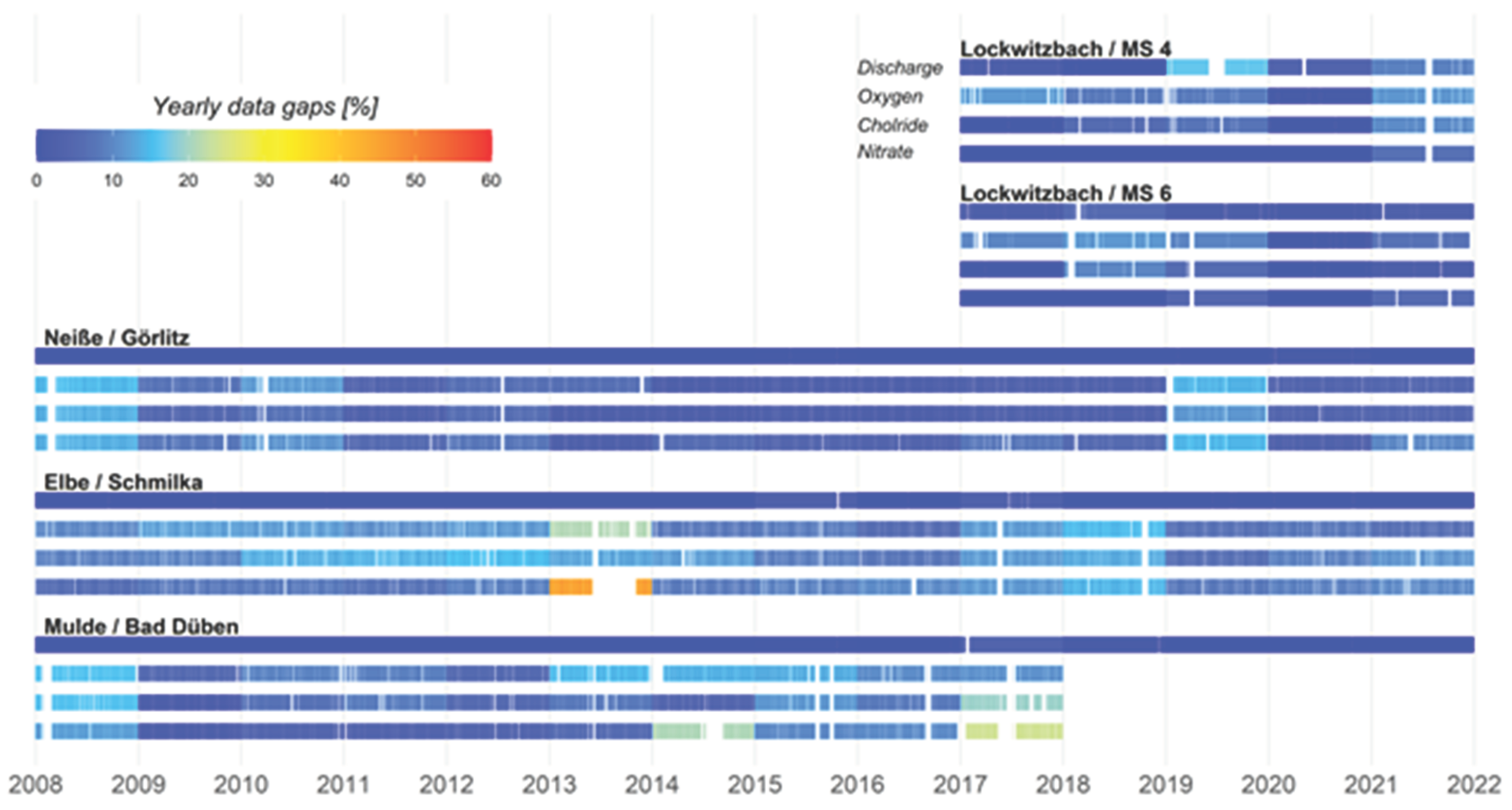
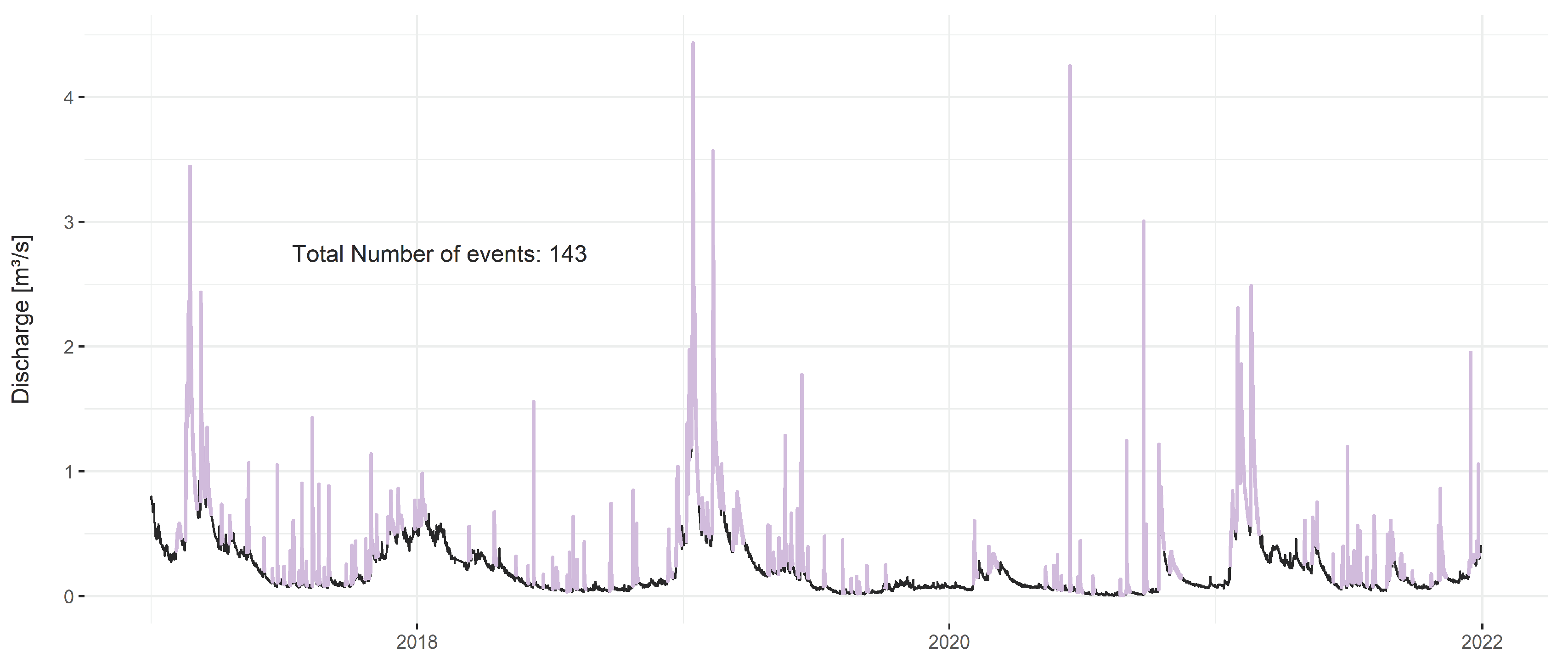
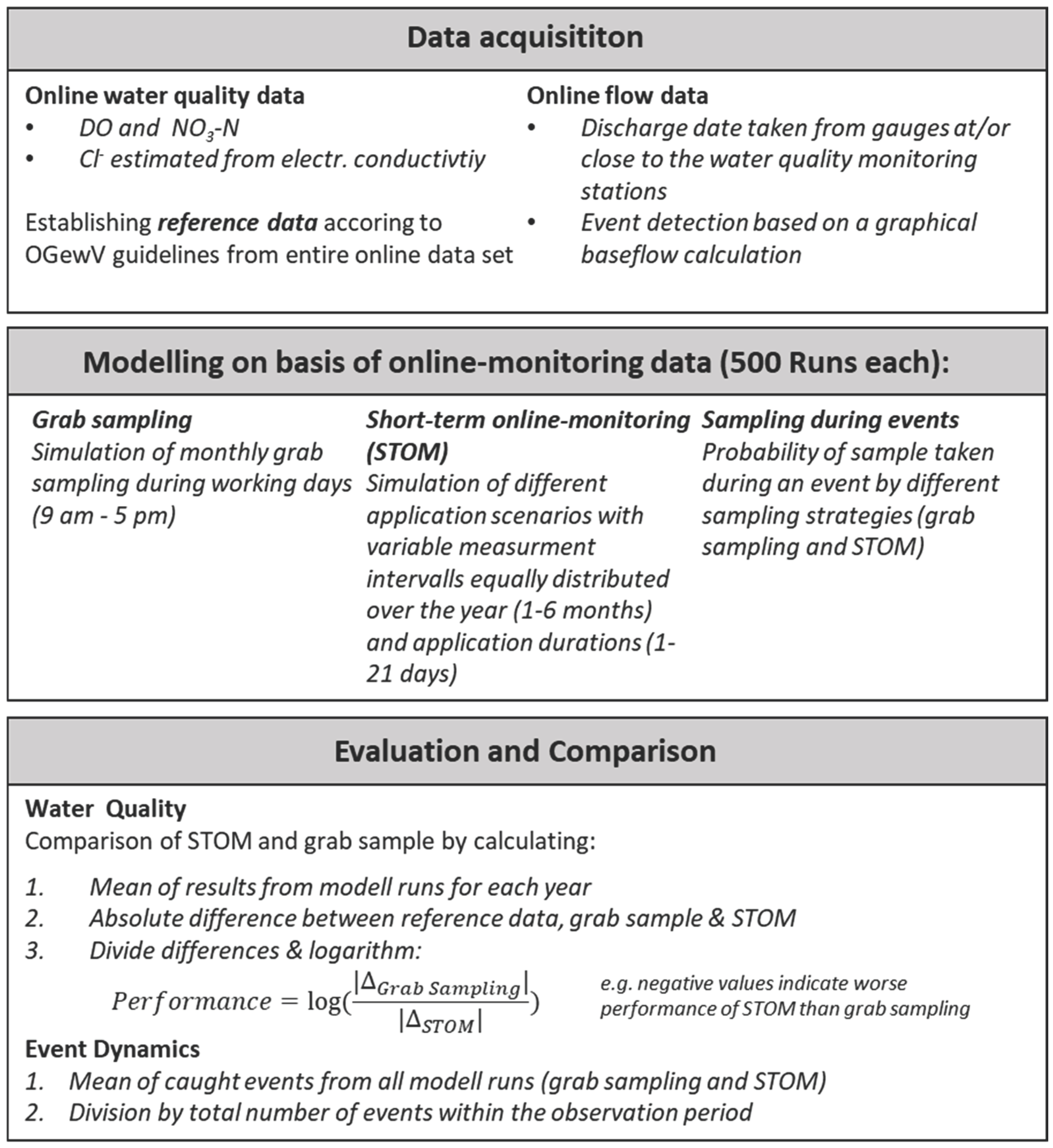
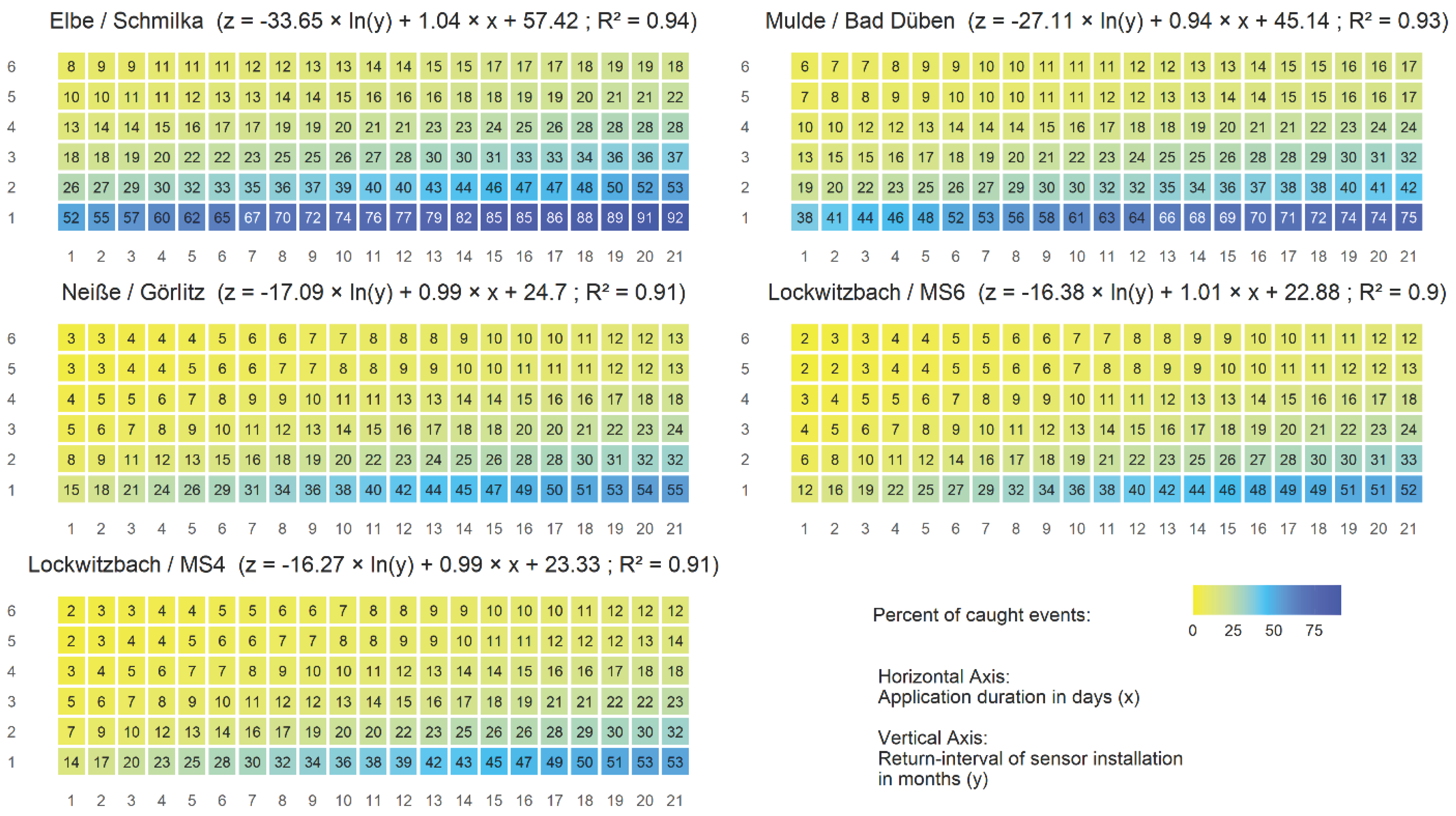
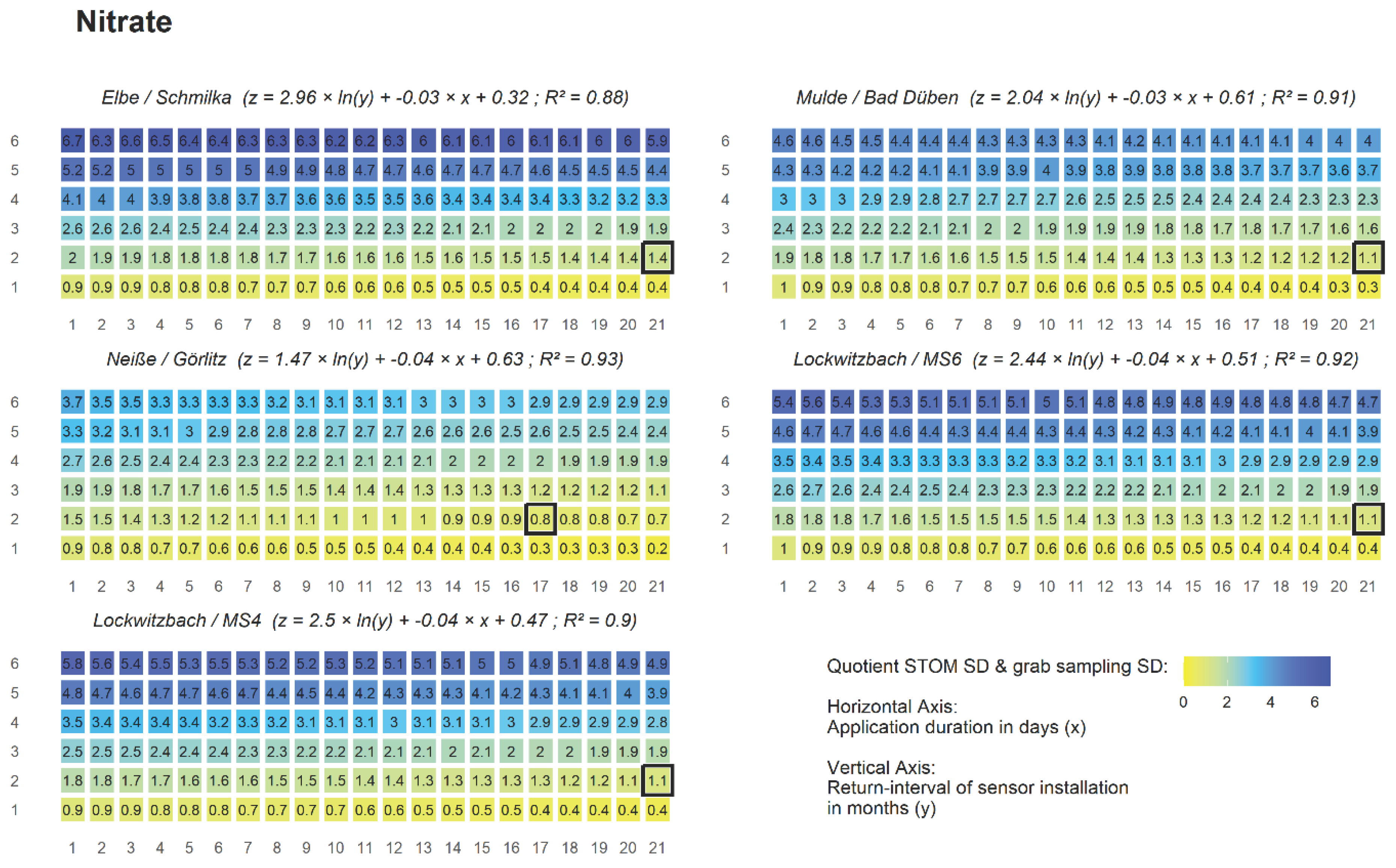
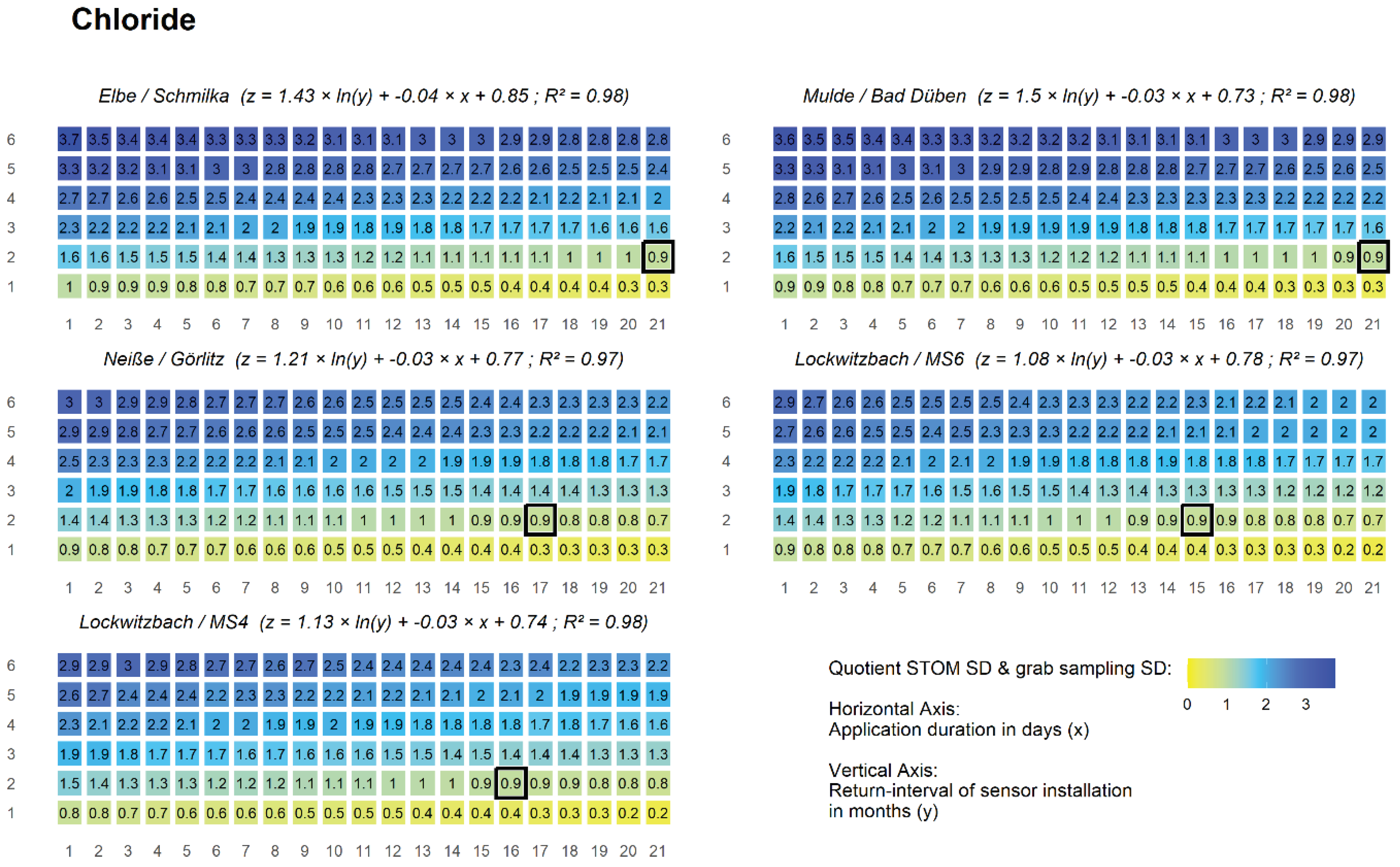
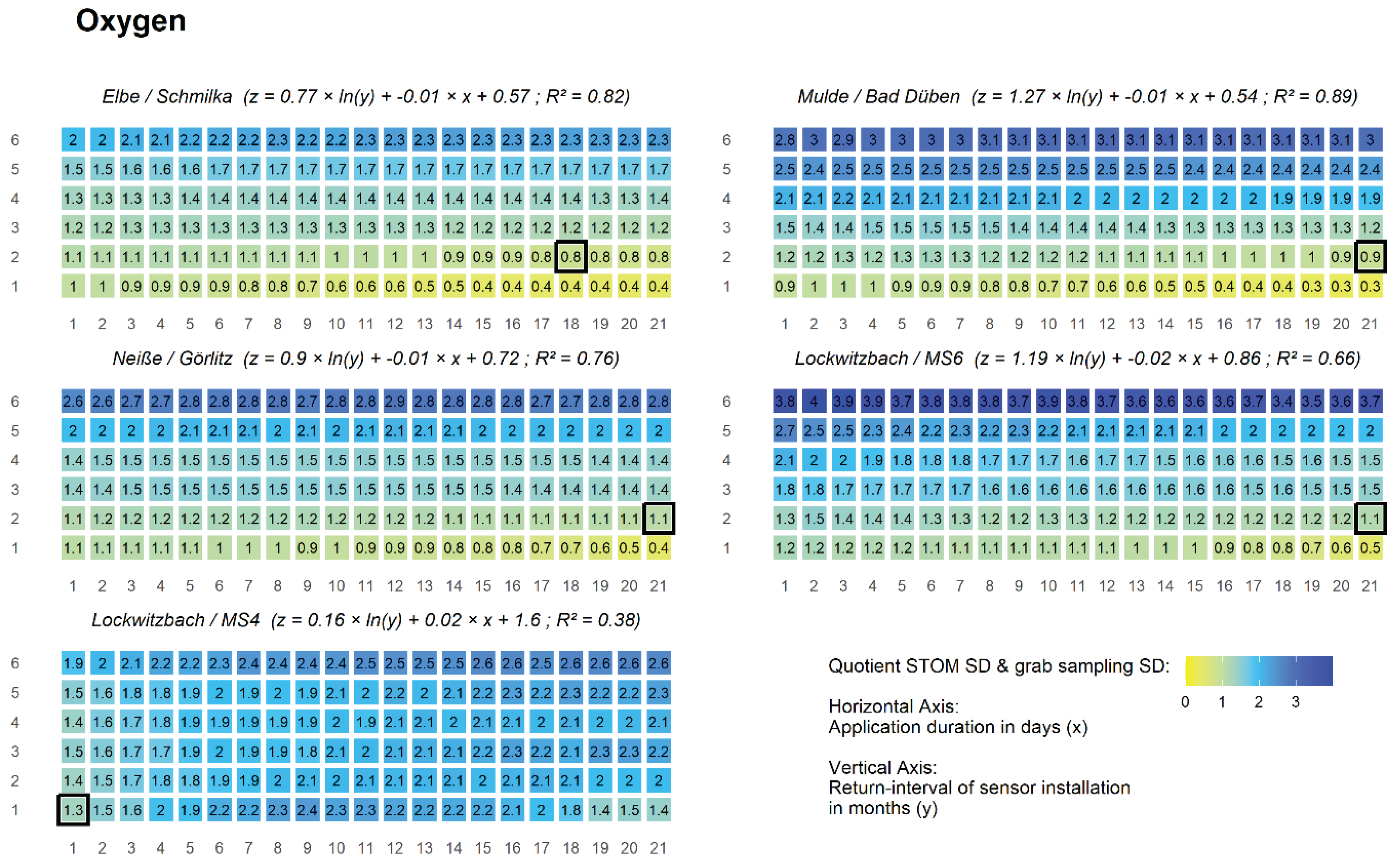
| Station | Catchment | Drainage area [km2] | Land Cover Type (%) | BFI | ||
|---|---|---|---|---|---|---|
| Settlements | Agriculture and pastures | Forest | ||||
| MS6 | Lockwitzbach | 73.3 | 9.2 | 72.8 | 18.0 | 0.71 |
| MS4 | Lockwitzbach | 84.0 | 18.0 | 67.5 | 14.5 | 0.70 |
| Görlitz | Lausitzer Neisse | 1632.7 | 13.0 | 51.0 | 35.0 | 0.81 |
| Bad Düben | Vereinigte Mulde | 6169.9 | 11.8 | 55.7 | 32.0 | 0.78 |
| Schöna | Elbe | 51391.0 | 6.4 | 54.9 | 37.6 | 0.77 |
| NO3-N [mg/l] | Cl [mg/l] | O2 [mg/l] | ||||||||||
|---|---|---|---|---|---|---|---|---|---|---|---|---|
| Summer | Winter | Summer | Winter | Summer | Winter | |||||||
| Day | Night | Day | Night | Day | Night | Day | Night | Day | Night | Day | Night | |
| Schmilka / Elbe | 3.1±0.8 | 3.1±1.1 | 4.9±1.1 | 4.9±1.1 | 41.4±8.4 | 40.7±10.5 | 40.6±10.5 | 40.6±10.5 | 9.4±1.8 | 9.3±1.3 | 11.8±1.3 | 11.8±1.2 |
| Bad Düben / Mulde | 2.8±0.6 | 2.8±0.9 | 3.6±0.9 | 3.6±0.9 | 29.7±4.5 | 29.4±4.4 | 30.1±4.4. | 30.5±4.4 | 8.3±1.8 | 8.5±1.5 | 11.7±1.6 | 11.7±1.6 |
| Görlitz / Neiße | 2.4±0.5 | 2.4±0.7 | 3±0.7 | 3±40.7 | 37.2±10.9 | 36.8±10.4 | 34±10.4 | 33.5±10.6 | 8.4±1.1 | 8.1±1.3 | 11.8±1.3 | 11.6±1.3 |
| MS6 / Lockwitzbach | 5.8±0.9 | 5.7±2.3 | 7.9±2.3 | 7.8±2.3 | 44.7±9.1 | 44.7±12.2 | 41.4±12.2 | 41.3±12.3 | 9.7±0.8 | 9.2±1.2 | 12.1±1.2 | 11.7±1.3 |
| MS4 / Lockwitzbach | 4.7±1.4 | 4.6±2.5 | 7.5±2.6 | 7.5±2.5 | 44.6±9.4 | 43.7±.12.3 | 39.9±12.3 | 39.6±12.3 | 10.5±2.3 | 7.7±1.9 | 12.9±1.9 | 11.2±1.7 |
Disclaimer/Publisher’s Note: The statements, opinions and data contained in all publications are solely those of the individual author(s) and contributor(s) and not of MDPI and/or the editor(s). MDPI and/or the editor(s) disclaim responsibility for any injury to people or property resulting from any ideas, methods, instructions or products referred to in the content. |
© 2024 by the authors. Licensee MDPI, Basel, Switzerland. This article is an open access article distributed under the terms and conditions of the Creative Commons Attribution (CC BY) license (http://creativecommons.org/licenses/by/4.0/).





